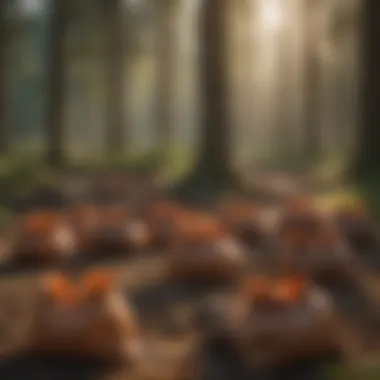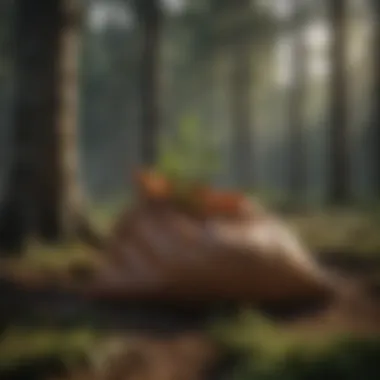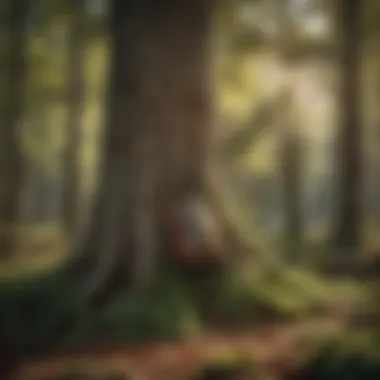Exploring the Role of Tree Planting Bags in Forestry


Intro
Tree planting bags have carved out a crucial niche in the realm of forestry and ecological restoration. These bags—simple yet effective—offer a multitude of benefits that extend far beyond just holding soil. This section initializes a deeper investigation into their role within tree cultivation and conservation strategies, aiming to elevate the understanding of practitioners and enthusiasts alike.
Within the varied landscape of forestry practices, tree planting bags serve as a bridge between intention and action. They support the root establishment of seedlings and contribute significantly to sustainable forestry efforts. As we traverse through the nuances of bag types, their environmental impacts, and the best practices associated with their deployment, we reveal the underlying mechanics of successful tree planting.
In this journey, we'll address a sensible array of considerations that ensure effective utilization, setting the stage for a forward-thinking approach to forestry. From the materials used in these specialized bags to the very methodologies that underpin their success, the narrative unfolds a comprehensive guide for anyone vested in the stewardship of our forests.
Evergreen Trees Species
Types of Evergreen Trees
Evergreen trees, with their resilient foliage and year-round beauty, play an indispensable role in American forests. Among the most notable species is the Ponderosa Pine, recognizable by its tall stature and thick bark, thriving primarily in the western United States. Another significant example is the Eastern White Pine, the state tree of Michigan, known for its towering form and soft needles.
Listed below are additional species that thrive in diverse habitats:
- Douglas Fir: Favored for timber and ornamental value.
- Redwood: Famous for being among the tallest trees globally.
- Spruce: With sharp needles, often associated with cold regions.
- Hemlock: Adapts well in shaded, moist environments.
Ecological Significance
The ecological importance of evergreen trees transcends mere aesthetics. They provide critical habitats for countless species and play a vital role in maintaining biodiversity. As stalwarts in photosynthesis, evergreens absorb carbon dioxide, contributing to air quality and climate stability. Moreover, their canopy offers shelter and nesting sites for various wildlife, from birds to mammals, ensuring a balanced ecosystem.
"Evergreen trees are the unsung heroes of our forests, not only enriching our landscapes but also supporting a myriad of life forms."
Conservation Practices
Efforts to protect and preserve evergreen species have become increasingly relevant in today's climate. Methods such as controlled burns and selective logging are pivotal in maintaining the health of these ecosystems. In addition, engaging local communities in conservation initiatives fosters a deeper understanding and appreciation of these trees, ensuring their longevity.
Forest Management Techniques
Wildlife Habitat Preservation
Successful forestry practices emphasize the importance of wildlife habitats. Implementing buffer zones and habitat corridors fosters biodiversity and preserves essential ecosystems. Strategies may include:
- Creating protected areas to minimize human disturbances.
- Restoration projects that reintroduce native species.
Sustainable Logging Practices
Sustainable logging encompasses a variety of methods focused on mitigating the environmental footprint. Techniques such as selective cutting reduce damage to surrounding trees, ensuring that forests remain robust and capable of regeneration.
Fire Prevention Measures
Fire prevention in forest management involves a multi-faceted approach, including controlled burns and careful monitoring of forest conditions. Utilizing technology for early detection offers an advantage in preserving these vital landscapes.
Ecosystem Restoration Initiatives
Projects aimed at restoring degraded lands often prioritize the re-establishment of native evergreen species, laying the groundwork for renewed ecological function and resilience. These initiatives help in reviving ecosystems and combatting land degradation, proving essential for a sustainable future.
Climate Change Impact on Evergreen Forests
Carbon Sequestration
One of the standout contributions of evergreen forests is their role in carbon sequestration. These trees absorb carbon dioxide, helping to mitigate greenhouse gas emissions. The potential of forests as carbon sinks cannot be overstated—they are vital in combating climate change.
Weather Pattern Effects
Climate change alters weather patterns, with evident impacts on the health of evergreen forests. Fluctuating temperatures and irregular precipitation affect growth rates and species distribution, posing challenges that must be addressed.
Biodiversity Support
The dynamic nature of climate change paves the way for shifts in biodiversity. Species that rely on specific habitats may face threats as their environments change, necessitating ongoing monitoring and adaptive management.
Localized Effects
Communities situated near evergreen forests witness firsthand the localized impacts of climate change. Understanding these effects is vital for developing targeted strategies that can enhance resilience and sustainability in both ecological and human systems.
Management and Preservation of Evergreen Forests
Historical Context
Exploring the historical significance of American evergreen forests adds depth to contemporary preservation efforts. These forests have harbored both cultural and ecological narratives that shape our current understanding and management practices.
Research Findings
Recent studies emphasize the importance of biodiversity within evergreen ecosystems. Emphasizing sustainable management practices has emerged as a crucial strategy for long-term preservation.


Conservation Efforts Showcase
Highlighting success stories of conservation initiatives reveals the potential for positive change. Various organizations work tirelessly to protect these landscapes, fostering hope for the future of American evergreen forests.
Preamble to Tree Planting Bags
The world of tree planting bags is not merely a footnote in the larger narrative of forestry and conservation; it’s a pivotal character with a story of its own. As we delve deeper into the relationship between tree planting and the bags designed to support this process, it becomes clear that these bags serve as more than just containers. They bring a suite of advantages that cater to both practical and ecological needs. Understanding their role can lead to more effective implementation and greater success in tree establishment efforts.
Definition and Purpose
Tree planting bags can be defined as specifically designed containers that support the growth of young trees during their early development stages. They come in various materials and designs, each serving a unique function. The primary purpose of these bags is to facilitate root establishment while minimizing transplant shock and maximizing survival rates for saplings. Furthermore, these bags help in providing a controlled environment, protecting young trees from pest damage and unfavorable weather. In essence, they act as a bridge, nurturing seedlings from nursery to field.
Historical Context
The concept of using bags for tree planting isn’t entirely new. The practice has roots that trace back to early horticultural techniques. Traditionally, trees were planted in bare root systems, which, while effective, came with a range of challenges—most notably, a shock to the plant when it was uprooted and placed into a new environment. The advent of tree planting bags can be seen as a response to these challenges.
In the late 20th century, as reforestation and conservation efforts gained momentum, the need for more innovative solutions became apparent. This led to the gradual adoption of materials like biodegradable fabrics and plastics designed specifically for tree planting. Over the years, the designs and materials used in tree planting bags evolved considerably, incorporating insights from botany, ecology, and materials science. This historical development reflected a growing recognition of the critical role these bags could play in successful forestry practices, contributing not only to the establishment of healthy trees but also to broader sustainability goals in environmental management.
Types of Tree Planting Bags
Understanding the different types of tree planting bags is crucial for anyone involved in forestry and conservation efforts. Each kind has its own benefits and drawbacks, which can significantly influence seedling growth and overall planting success. Selecting the right type can make a world of difference in the long run—it's not just about aesthetics; it's about ensuring that the plants thrive.
Fabric Bags
Fabric bags have gained a foothold in the world of tree planting. These are typically made from breathable materials, which allows for great air circulation. The porous nature of fabric bags can promote healthy root development, as the roots can grow outward without being constricted. Furthermore, the ability for moisture to escape prevents overwatering, reducing the likelihood of root rot.
A classic example of a fabric bag is the Smart Pot, which has become popular among both casual gardeners and horticultural experts alike. Users appreciate how these bags encourage the production of a fibrous root system, as the roots tend not to circle back upon themselves, a common problem observed in rigid containers. This means plants are often healthier and more resilient once they are finally planted in the ground.
Plastic Bags
On the flip side, plastic planting bags are widely used due to their affordability and convenience. However, their rigid structure can pose challenges. When using plastic bags, there’s a significant chance of roots becoming bound due to insufficient air circulation. A reality many don’t know is that these bags should ideally be used for short-term purposes—once seedlings reach a certain size, they should be transitioned to larger planting containers, if not planted directly in the ground.
Prominent brands like TreeKeeper offer a variety of plastic planting bags. While inexpensive and easy to handle, plastic bags might not provide the best environment for sustained root growth, which can lead to complications when attempting to transplant. It’s essential to be mindful of this when opting for plastic; they can serve a purpose but might not be the optimal long-term solution.
Biodegradable Options
In recent years, a move towards sustainability has sparked interest in biodegradable planting bags. These bags can decompose naturally over time, which aligns with a growing emphasis on eco-friendly practices in forestry. Typically made from materials like starch or recycled substances, biodegradable bags can provide a great solution for those concerned about their environmental footprint.
An example of a biodegradable option is the BioPot, which breaks down after being planted in the ground. This means that as the tree grows, it isn’t hindered by plastic or rigid materials, supporting seamless root expansion. These bags eliminate the worry of disposal, as they don’t contribute to landfill waste. However, care should be taken regarding the timing of planting to ensure that the bags decompose at an appropriate rate for the growing plants.
In light of these various options, it becomes clear that the choice of tree planting bag should be guided by specific needs, goals, and environmental considerations. By understanding the unique characteristics and implications of each type, practitioners can better equip themselves to promote successful growth in trees, ultimately contributing to more effective and sustainable forestry practices.
Benefits of Using Tree Planting Bags
Tree planting bags serve a crucial function in the realm of forestry and conservation. Their significance is woven into the very fabric of how trees are nurtured and established. These bags offer several advantages that not only promote healthier trees but also enhance overall forest sustainability. Understanding these benefits provides essential insights for those involved in forestry, from professionals to academic researchers.
Root Development Support
One of the standout benefits of tree planting bags lies in their ability to support root development. Unlike traditional planting methods, these bags allow roots to grow naturally without being hindered by external barriers. When trees are planted in bags, the roots can penetrate freely into the soil, establishing a robust anchorage system. This leads to more resilient trees, capable of withstanding environmental stresses such as drought or high winds. Furthermore, the permeable nature of many fabric bags encourages air circulation and moisture absorption, which is vital for healthy root progression.
Did you know? Tree roots confined in pots or non-porous materials can become root bound, ultimately stunting growth. Hence, leveraging tree planting bags for their improved rooting possibilities is a step towards sustainable forestry practices.
Reduction in Transplant Shock
Transplant shock can be a deal breaker for newly planted trees, often leading to stunted growth or even death. However, with tree planting bags, the impact of transplant shock is notably reduced. This reduction comes from the bags' design, which facilitates a gentler transition from the nursery to the planting site.
By keeping the root ball intact, the tree experiences less disturbance during handling and planting. The bag protects the roots during transportation, allowing them to stay moist and secure. Moreover, the gradual acclimatization that bags allow helps trees adapt better to their new environment. Many forestry experts have noted a stark improvement in survival rates when tree planting bags are employed—an encouraging statistic for anyone looking to maximize planting success.
"Trees in bags adapt better, thrive faster, and reduce losses during transplanting. This is pivotal in sustainable forestry management!"
Easier Transportation and Handling
Transporting young trees can sometimes feel like moving mountains, but tree planting bags lighten that load—literally. Bags are lightweight and often designed for easy handling, making the logistics of planting far more manageable. Whether it’s moving seedlings from a nursery to a planting site or relocating mature trees for urban forestry projects, these bags simplify the task.
Consider this: using tree planting bags can cut down on vehicle loads and reduce the chances of injury during transport. Furthermore, many bags can be stacked easily, utilizing space efficiently during transit. This not only minimizes the carbon footprint associated with transportation but also enhances the overall operational efficiency of forestry work.
In summary, the benefits of using tree planting bags extend beyond mere convenience; they play a formidable role in fostering healthier trees while simultaneously supporting efficient forestry practices. Understanding these benefits equips professionals with the knowledge to make better choices in tree planting and care, ultimately contributing to the successful establishment of forests.
Material Considerations
Understanding the material aspects of tree planting bags is crucial for both effectiveness and sustainability. The choice of materials can significantly influence the success of saplings in their formative stages. Various elements need scrutiny, such as durability, how long the bag lasts in the field, and the potential impact on the surrounding soil.
Durability and Longevity
When it comes to tree planting bags, durability often makes or breaks the effectiveness of planting efforts. You want something that won’t fall apart at the first sign of rain or wear down under harsh sunlight. Bags made from high-quality fabric like polypropylene gain brownie points because they can withstand environmental stressors longer than ordinary plastic bags. In contrast, flimsy options might get shredded in no time, leaving roots exposed and vulnerable.
A durable bag extends the longevity of your planting project. It ensures that the trees spend enough time in optimal conditions for healthy root development before being transplanted. If the bag degrades too quickly, it does not allow trees to acclimatize to their new environment, leading to transplant shock when they finally go into the ground. Thus, investing in long-lasting materials can spell the difference between thriving trees and dismal failures.


Impact on Soil Health
Next, we wade into how planting bag materials affect soil health. The bag shouldn’t be merely a vessel; it should contribute positively to the soil it interacts with. Some bags release harmful chemicals into the environment, altering nutrient profiles in the soil. This can be detrimental, especially for young trees still establishing their roots.
Conversely, certain biodegradable options like jute or recycled materials can actually enhance soil microbiomes. They break down over time, slowly enriching the soil with organic matter. This not only supports the trees but also allows surrounding flora to flourish. It becomes a symbiotic relationship, rather than a one-sided affair where only the tree benefits.
To summarize, when considering materials for tree planting bags, one must take into account both durability for practical longevity and the potential impacts on soil health. Selecting the right materials contributes not only to individual planting success but also to the broader ecosystem.
Application Techniques
When it comes to planting trees using bags, application techniques play a pivotal role in ensuring successful growth and establishment. Effective techniques are not just about putting a tree in the ground; they encompass a range of considerations from preparation to watering. Understanding these techniques can make a marked difference in how well a tree thrives after being planted.
Site Preparation
Preparation of the site is often the unsung hero in the realm of tree planting. It's more than just digging a hole and throwing the tree in. The concept of site preparation means analyzing the soil condition, topography, and existing vegetation to create an optimal environment for the planted tree. Prior assessment of the soil is crucial—amending it with organic matter or nutrients can help mitigate nutrient deficiencies, setting the stage for better root growth.
- Soil Quality: Check the pH level and texture. Certain trees thrive better in sandy soils, while others prefer clay.
- Weed Control: Remove invasive weeds that can compete for water and nutrients. Having a clean slate can significantly boost survival rates.
- Space Management: Ensure enough spacing for trees based on their eventual size. Overcrowding can lead to stunted growth.
Taking time for site preparation saves headaches later, as a well-prepared site promotes strong root development and minimizes potential transplant shock.
Optimal Planting Depth
Planting depth might not seem like a big deal, but it's a crucial element that can determine a tree's long-term success. Dropping the seedling too deep can suffocate roots, while too shallow planting can expose them to harsh conditions.
- General Rule: The top of the root ball should be level with the soil surface. This allows the tree to properly anchor itself while avoiding moisture accumulation on the trunk.
- Specific Species Needs: Different species may have specific requirements. Some trees have a taproot that needs more room, while others spread out horizontally.
- Adjustments for Soil Type: Wet soils might require a slightly elevated position to prevent excess water from pooling around the trunk.
Correctly addressing the planting depth will ultimately result in a robust and healthy tree that can withstand the elements.
Watering Practices
Watering is not just a routine task; it's the lifeblood for newly planted trees. The challenge lies in ensuring the tree gets enough water without oversaturating the soil.
- Immediate Watering: Right after planting, give the tree a thorough soak. This helps to settle the soil around the roots and eliminates air pockets.
- Regular Schedule: After the initial watering, trees typically need consistent moisture until they are established. Weekly deep watering is generally advised, depending on the climate and tree species.
- Mulching Benefits: Using mulch can help retain moisture and regulate soil temperature. It also curbs competition from weeds. Just keep mulch a couple of inches away from the trunk to prevent rotting.
Good watering practices are integral for root establishment and long-term vitality.
"Failing to prepare is preparing to fail."
Site preparation, planting depth, and watering practices are interconnected components that collectively influence the fate of a tree planted in a bag. By taking a thoughtful approach, practitioners can enhance the chances of successful growth outcomes.
Challenges in Usage
Understanding the challenges associated with tree planting bags is crucial for anyone engaged in forestry or conservation efforts. While these bags certainly offer many advantages, such as facilitating root development and improving transplant success, they also come with a set of challenges that can impact their effectiveness. Addressing these issues is essential to ensure that both practitioners and environmental enthusiasts can maximize the positive contributions of tree planting bags to sustainable forestry practices.
Root Bound Issues
Root bound, a term that can ring alarm bells for those who dwell in the realm of plant cultivation, refers to the phenomenon where the roots of a plant grow in a circular pattern and become constricted by the container they are in. In tree planting bags, this situation can arise if the bag is used for too long, or if the planting technique doesn’t allow for adequate root expansion.
Once a tree's roots become bound, it can face a host of detrimental effects: the growth will generally stunt, and the overall health of the plant may decline. Several factors contribute to this issue, including:
- Material Thickness: Thicker materials can impede root growth, preventing them from breaking through easily.
- Planting Depth: If a tree is not planted deep enough or too shallow, the roots may not spread effectively.
- Infrequent Transplanting: Keeping the tree in the bag without transferring it to more suitable conditions can lead the roots to circle around.
To mitigate root bound issues, it’s beneficial to periodically check the root structure and ensure optimal transplanting practices are followed. One approach some professionals recommend is to make vertical slices through the outside of the bag after a certain growth period. This simple step can encourage the roots to grow outwards rather than spiral.
"Addressing root bound issues at the outset can save years of regeneration efforts and make a world of difference to the trees’ establishment and longevity."
Environmental Concerns
Another significant challenge revolves around environmental considerations. The materials used in tree planting bags, whether they be fabric, plastic, or biodegradable, play a pivotal role in their ecological impact.
- Plastic Bags: Non-biodegradable plastic bags are often criticized for their contribution to pollution and their detrimental effects on soil health. When these bags break down, they can lead to microplastics permeating the soil, which poses threats to soil microbiomes.
- Chemical Runoff: Any chemicals present in the bag materials, especially in certain plastic varieties, can leach into the soil and cause adverse effects on the environment and nearby flora and fauna.
- Waste Generation: Used tree planting bags can contribute to landfill waste if not properly disposed of or recycled. The disposal techniques and lifecycle of these bags are critical factors for consideration in sustainable practices.
Thus, while tree planting bags serve practical purposes, their environmental ramifications cannot be ignored. It’s paramount for those in the field to select materials wisely and to develop strategies for recycling or reusing bags. By consistently evaluating the ecological footprint of these planting tools, forestry professionals can continue to advance sustainable practices that balance practicality with environmental responsibility.
With knowledge and awareness, addressing these challenges not only safeguards individual plants but also furthers the overarching goals of conservation and sustainability within forestry.
Sustainability Considerations
Sustainability is not just a buzzword; it's a necessity for modern forestry. In the realm of tree planting bags, this concept takes on various dimensions. Understanding how these bags fit into sustainable practices exceeds mere compliance and delves into ethical stewardship of resources. Tree planting bags can contribute to a healthier ecosystem and promote biodiversity when chosen and utilized wisely.
Recyclability of Materials
One of the foremost elements of sustainability concerns the recyclability of the materials used in manufacturing tree planting bags. From traditional plastic to innovative biodegradable options, the material choice has a significant impact on waste management and environmental footprint.
- Plastic: Many tree planting bags are made from polyethylene, a material that, while durable, poses a recycling challenge. If disposed of incorrectly, these bags can linger in landfills for centuries. However, some companies are beginning to produce recyclable variants that can reduce waste and contribute to responsible consumption.
- Biodegradable Options: These are gaining traction in the market as they break down naturally, returning nutrients to the soil. Such bags can be made from materials like corn starch or other bio-based substances, thus enhancing soil health after use. Nevertheless, the degradation process can vary significantly based on environmental conditions, and there isn't a one-size-fits-all solution.
- Innovative Solutions: Some manufacturers are experimenting with hybrid materials that combine the durability of plastic with the ecological benefits of biodegradable compounds. These innovative approaches can lead to a reduced environmental impact while still supporting the tree growth process effectively.
One takeaway here is that while the recyclability of tree planting bags is vital, it's essential for consumers—be it agriculturalists or hobbyist planters—to educate themselves on local recycling protocols and choose products that truly support ecological sustainability.


Impact on Carbon Footprint
The carbon footprint associated with tree planting bags often remains an overlooked aspect of sustainable forestry. Various factors influence this impact, chiefly the materials used, the manufacturing processes, and transportation.
- Manufacturing Processes: The energy required to produce tree planting bags significantly contributes to their carbon footprint. For instance, making virgin plastic from fossil fuels emits a considerable amount of carbon dioxide. However, opting for bags produced from recycled materials can offer a notable reduction in emissions.
- Transportation: Heavy and bulky products imply increased fuel use during transit. Choosing local manufacturers or lighter weight options can mitigate this aspect of the carbon footprint.
- Lifecycle Analysis: It is imperative to consider the entire lifecycle of tree planting bags. From production to disposal, every stage has its carbon implications. Comprehensive lifecycle analyses can help stakeholders identify specific weaknesses and areas for improvement within their supply chains.
When evaluating the sustainability of tree planting bags, it’s clear that there is no silver bullet, but adopting a holistic approach can lead to more responsible decisions. By being mindful of materials, manufacturing, and transportation choices, forestry professionals can significantly minimize the carbon emissions linked to their operations.
"To sustain our forests, we must also sustain our practices. Choosing recyclable and low-carbon options is a stride towards a healthier planet."
In sum, sustainability considerations regarding tree planting bags extend well beyond their initial function. By factoring in recyclability and carbon footprints, stakeholders can ensure they contribute positively to global environmental goals.
Regulatory Standards
Understanding the significance of regulatory standards in the context of tree planting bags is a critical aspect of ensuring sustainable forestry and environmental protection. These standards not only pave the way for the safe and effective use of tree planting bags but also help in maintaining consistency across various applications, guaranteeing that practices align with environmental goals.
Regulatory standards serve as a framework that guides manufacturers, users, and forestry professionals in the responsible use of materials and techniques associated with tree planting. They help in avoiding practices that could lead to ecological harm, thereby fostering a healthier environment. Compliance with these standards often results in improved advocacy for tree planting and conservation efforts, ultimately benefiting both the ecosystem and the community.
Compliance with Environmental Laws
Compliance with environmental laws is paramount in the realm of forestry and conservation. Tree planting bags, by their very nature, must meet specific environmental criteria to ensure that they do not contribute to pollution or habitat degradation. This compliance involves several layers, including proper material sourcing, production processes, and end-of-life disposal considerations.
For instance, the use of biodegradable materials in tree planting bags must align with standards set forth by relevant environmental authorities. This means that not only do the bags need to break down in natural conditions, but they should do so without releasing harmful substances. Proactive measures by manufacturers to adhere to these laws can foster trust within communities regarding reforestation and conservation initiatives.
Moreover, compliance with these laws often entails rigorous testing and certification processes. This can include evaluating the performance of the bags in various soil types and climates or ensuring that any chemicals used in their production do not leach into the soil. These evaluations also create data that can inform future decisions about materials and methods in tree planting, ultimately optimizing planting success.
Industry Best Practices
Following industry best practices regarding tree planting bags can set the standard for excellence in forestry operations. These practices encompass a variety of elements, from material selection to application techniques.
- Material Selection: Choosing high-quality materials that align with environmental standards is vital. Options like fabric or biodegradable bags are often favored due to their minimal environmental impact.
- Proper Handling and Storage: Proper storage of tree planting bags prior to use helps to maintain their integrity. Bags should be kept dry and away from direct sunlight when not in use, preserving their functional life and effectiveness.
- Planting Techniques: Adopting best practices during the planting process, such as ensuring the right depth and spacing between bags, aids in optimal root development. This can significantly enhance the survival rate of young trees.
- Monitoring Post-Planting: Post-planting evaluations can offer insights into the success of the planting procedure. Monitoring the growth of trees within planting bags helps identify any adjustments needed for future projects.
In essence, adhering to industry best practices enhances the reliability of tree planting bags in various environments. They not only promote sustainability but also lead to more successful reforestation efforts.
"Regulatory standards and best practices are the backbone of effective tree planting strategies, ensuring the success of ecological restoration initiatives."
By integrating these standards and practices, we pave the way toward a more sustainable approach to forestry. Constant evaluation and adaptation to emerging research ensure that tree planting activities continue to meet environmental needs while fulfilling human aspirations.
Case Studies
Exploring case studies of tree planting bags reveals practical insights that can significantly inform future strategies in forestry and conservation efforts. Through real-world examples, we can understand not just the successes but also the pitfalls encountered along the way. These narratives serve both as beacons and cautionary tales for practitioners looking to optimize their use of tree planting bags.
Successful Implementations
In various regions around the world, successful implementations of tree planting bags have showcased the potential gains in this particular area of forestry. A notable case is found in the forests of northern California, where local agencies utilized fabric tree planting bags to support the reforestation efforts after the wildfires. These bags were filled with a nutrient-rich soil mix, tailored to promote healthy root development.
The observed results were promising:
- Over 80% survival rate of newly planted saplings
- Reduced soil erosion on slopes due to effective moisture retention
- Easier fieldwork due to lightweight bags compared to traditional containers
Moreover, the experience in California highlighted a collaborative approach—combining the expertise of local forestry officials, volunteers, and non-profits. This ensured that the tree planting efforts not only had the right materials but also involved community participation, which in turn raised awareness regarding environmental stewardship.
Lessons Learned
While the successful implementations provide a positive outlook, it is equally important to examine the lessons gleaned from them. For instance, in a case study from Australia, it became evident that the choice of tree planting bags significantly influenced the outcomes. When a decision was made to switch from plastic bags to biodegradable ones, there was a noticeable improvement in the establishment rate of seedlings.
However, not everything went smoothly. The Australian project faced some challenges, such as:
- Unexpected root bound issues with biodegradable bags that didn’t degrade as quickly as anticipated
- Initial higher costs associated with sourcing of materials
In reflecting on these experiences, the project leaders noted that rigorous pre-implementation checks are crucial. Understanding the local soil types, as well as climate conditions, is essential for selecting the right kind of bag and its filling.
To raise the bar higher, ongoing monitoring and field assessments were recommended. It’s not merely about planting trees; consistent follow-ups create opportunities for adjustments in practices, aligning them with the dynamic environmental factors.
In sum, these case studies serve as vital tools for learning, unearthing insightful strategies while pinpointing the snares that can trip up even the best-laid plans.
Future Trends in Tree Planting Bags
As the global community increasingly prioritizes sustainable practices, the innovations surrounding tree planting bags are not just beneficial but essential in the quest for greener forestry practices. This segment dives into what's on the horizon, weaving together themes of material advancements and groundbreaking technologies that promise to reshape how we approach reforestation and conservation efforts.
Innovative Materials
With environmental concerns at the forefront, the quest for new materials loves to take center stage. Traditional plastic bags are being challenged by eco-friendlier options that serve as alternatives while minimizing pollution. For instance, bio-based plastics made from renewable sources like cornstarch showcase the potential for creating bags that can degrade over time without harming the ecosystem. Also, companies are experimenting with mycelium composites, which not only provide sturdiness but also enrich the soil when they decompose. This shift towards biodegradable materials reflects a commitment to reducing our carbon footprint that prioritizes trees and health of soil.
With these materials, the benefits are two-fold. Not only do they serve the practical purpose of housing and nurturing young plants, but they also contribute to a larger ecological narrative. Yet, moving from concept to widespread application comes with its challenges. Manufacturing processes need to evolve, and consumers must embrace these materials, making adoption a gradual journey requiring education and marketing.
Technological Advancements
Technology is leaping forward with a promise to enhance the efficiency of tree planting bags significantly. One noteworthy advancement includes the development of smart planting bags equipped with sensors that monitor moisture levels and nutrient availability in the soil, sending data back to users via mobile apps. This immediate feedback loop can assist in making informed decisions, ensuring that young trees receive the right amount of care right from the get-go.
Another exciting direction is the integration of RFID (Radio Frequency Identification) tracking in tree planting bags, which allows for accurate inventory management and monitoring of plant development over time. This technology enforces accountability and traceability, essential factors in sustainable forestry.
"The innovation in tree planting bags reflects the convergence of ecology and technology, where advancing materials and smart solutions work hand-in-hand to nurture future forests."



